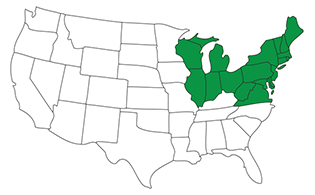
Hairy Chinch Bug
Blissus leucopterus hirtus
The Hairy Chinch Bug is a unique lawn-damaging insect that changes colors throughout each nymph stage. Also known as Blissus leucopterus hirtus, this lawn pest is typically found in the northeastern part of the United States, attacking Kentucky Bluegrass, Perennial Ryegrass, Creeping Red Fescue and Creeping Bentgrass.
Identify

Crown & Thatch
An adult Hairy Chinch Bug is gray to black in color and covered with fine hairs. This lawn pest also has white wings with an identifying black spot located on the front middle edge, and burnt-orange-colored legs. Sometimes this lawn insect can sprout short wings that end halfway down its abdomen. The Hairy Chinch Bug is nearly identical in appearance to the Southern Chinch Bug—the region you find each lawn pest living (i.e., the area of adaptation) is the easiest way to identify each one. The Hairy Chinch Bug also undergoes five nymphal stages, all of which result in different color and markings, that can serve as key identifying characteristics. Many of the instar stages feature a cream-colored band around the abdomen. Initial signs of Hairy Chinch Bug damage in your lawn include irregular, wilted yellow and brown patches of grass that could resemble drought stress. Feeding from this lawn-damaging insect disrupts the plant from properly moving water, preventing recovery. This lawn insect is most active for growth and development in dry conditions, which is another reason why drought stress can often mask Hairy Chinch Bug damage. Sometimes the damage isn't seen until your lawn fails to green-up once the drought stress is no longer a problem.
Life Cycle
This lawn pest overwinters as an adult and then become active when daytime temperatures reach 70°F. Females lay their eggs either into the folds of grass blades or into thatch. The late-hatching nymphs do not survive the winter months, leaving lawns to deal with two generations of Hairy Chinch Bugs per year.

Control
There are two methods for controlling Hairy Chinch Bugs that TruGreen® recommends: 1. Use professionally applied pest control designed to prevent excess lawn pest populations, which can cause damage to your lawn 2. Kill insects, grubs and other lawn pests before they have a chance to damage your lawn Proper mowing and watering techniques can also help foster a healthy lawn that's more tolerant to lawn pest attacks—plus you'll get a lawn you'll want to live on in the process.







